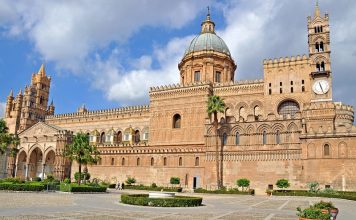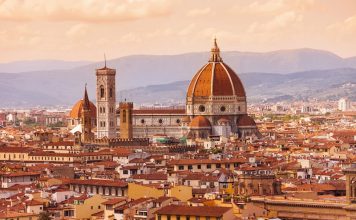Naples is a city in southern Italy that is famous for its pizza, its volcano, its history, and its culture. Naples is the birthplace of pizza, a dish that has become a symbol of Italian cuisine and a UNESCO intangible cultural heritage.
What is Naples Famous For?
Naples is also the home of Mount Vesuvius, the volcano that erupted in 79 AD and destroyed the ancient cities of Pompeii and Herculaneum. Naples is also a city of history and heritage, with more than 2,500 years of civilization and a UNESCO World Heritage Site since 1995. Naples is also a city of culture and art, with many museums, churches, palaces, and monuments that display some of the most famous and valuable artworks in the world, such as the Veiled Christ by Giuseppe Sanmartino, the Seven Works of Mercy by Caravaggio, and the Farnese Bull by Apollonius of Tralles.
Famous Drinks in Naples
Naples has a variety of drinks that reflect its history, culture, and taste. Some of the most famous drinks in Naples are:
- Coffee: Coffee is one of the most popular drinks in Naples and Italy in general. Italians love their coffee and have many different ways of preparing it, such as espresso, cappuccino, macchiato, latte, and more. Coffee is usually consumed in the morning or after meals, and sometimes with a pastry or a sfogliatella (a shell-shaped filled pastry). Coffee is also an essential part of the social life in Naples, as people often meet at cafes to chat and relax.
- Limoncello: Limoncello is a liqueur that originated in the Amalfi Coast near Naples and is one of the most famous products of the region. Limoncello is made from lemons, sugar, water, and alcohol. Limoncello has a bright yellow color and a sweet and sour taste. Limoncello is usually served chilled as a digestif (a drink after a meal) or as a cocktail ingredient.
- Falanghina: Falanghina is a white wine that also originated in the Campania region around Naples and is one of the oldest grape varieties in Italy. Falanghina is a dry and fruity wine that has aromas and flavors of citrus, apple, pear, and floral notes. Falanghina is often paired with seafood dishes, such as spaghetti alle vongole (spaghetti with clams) or frittura di paranza (fried mixed fish).
- Lacryma Christi: Lacryma Christi (meaning “tears of Christ”) is a wine that is produced on the slopes of Mount Vesuvius near Naples. Lacryma Christi can be red or white, depending on the type of grapes used. Lacryma Christi has a legend that says that when Jesus saw the beauty of the Bay of Naples from Mount Vesuvius, he cried tears of joy that fell on the vines and gave them their unique flavor. Lacryma Christi is a full-bodied and aromatic wine that has notes of cherry, plum, berry, and spice.
- Chinotto: Chinotto is a soft drink that was invented in Genoa but became popular in Naples as well. Chinotto is made from chinotto oranges, a type of citrus fruit that grows in Italy. Chinotto has a dark color and a bitter-sweet taste. Chinotto is often consumed as an alternative to cola or as a mixer for alcoholic drinks.
Famous Sports in Naples
Naples is a city that loves sports and has many teams and events that represent it. Some of the most famous sports in Naples are:
- Football: Football is arguably the most popular sport in Naples, both among locals and visitors. Naples has one professional football team: SSC Napoli, which plays in Serie A (the top division of Italian football). SSC Napoli was founded in 1926 and has won two Italian championships and one UEFA Cup title in its history. SSC Napoli plays at the Stadio San Paolo, which has a capacity of about 60,000 seats. SSC Napoli has many loyal fans who cheer them on at every game.
- Water polo: Water polo is another sport that has a long history and tradition in Naples. Naples has one professional water polo team: Circolo Nautico Posillipo, which plays in Serie A1 (the top division of Italian water polo). Circolo Nautico Posillipo was founded in 1925 and has won 12 Italian championships and 4 LEN Champions League titles in its history. Circolo Nautico Posillipo plays at the Piscina Felice Scandone, which has a capacity of about 2,000 seats. Circolo Nautico Posillipo has many passionate fans who support them at every game.
- Sailing: Sailing is a sport that has a strong connection to Naples, as the city is located on the Gulf of Naples. Sailing is a sport that involves navigating a boat with sails using the wind and the waves. Sailing is a sport that requires skill, strategy, and teamwork. Naples has several sailing clubs and schools that offer courses and lessons for beginners or experts. Naples also hosts several sailing events, such as the America’s Cup World Series, the Rolex Capri Sailing Week, and the Trofeo Princesa Sofia.
- Basketball: Basketball is a sport that has grown in popularity and success in Naples over the years. Naples has one professional basketball team: Basket Napoli, which plays in Serie A2 (the second division of Italian basketball). Basket Napoli was founded in 1995 and has won one Coppa Italia LegaDue title in its history. Basket Napoli plays at the PalaBarbuto, which has a capacity of about 5,000 seats. Basket Napoli has many loyal fans who cheer them on at every game.
- Skiing: Skiing is a sport that is not very common in Naples but can be enjoyed in the nearby Apennines. The Apennines are some of the most spectacular and challenging mountains for skiing, with many resorts, slopes, trails, and lifts. Some of the best ski destinations near Naples are Roccaraso, Campitello Matese, Campo Felice, and Monte Terminillo. Skiing is a fun and exhilarating activity that can be done by beginners or experts.
Famous Streets in Naples
Naples has some of the most interesting and iconic streets in Italy, where you can find history, culture, entertainment, and shopping. Some of the most famous streets in Naples are:
- Via Toledo: Via Toledo is a street that runs through the historical center of Naples and is known as one of the most lively and vibrant streets in the city. Via Toledo is home to some of the most important and famous landmarks in Naples, such as Piazza del Plebiscito (the main square of Naples), Palazzo Reale (the royal palace of Naples), Teatro San Carlo (the oldest opera house in Europe), and Galleria Umberto I (a 19th century arcade that houses many shops and cafes). Via Toledo is also a street of contrasts, as it mixes old and new, rich and poor, sacred and profane. Some of the examples are Castel Nuovo (a medieval castle that overlooks the sea), Quartieri Spagnoli (a densely populated and colorful neighborhood), Santa Chiara (a Gothic church that contains a majolica-tiled cloister), and Pio Monte della Misericordia (a charitable institution that displays a masterpiece by Caravaggio).
- Spaccanapoli: Spaccanapoli (meaning “Naples splitter”) is a street that literally splits Naples into two parts: the upper part (the Vomero hill) and the lower part (the historical center). Spaccanapoli is a street of history and heritage, with many monuments and museums that tell the story of Naples’ past, such as Palazzo Venezia (a Renaissance palace that was the residence of the Spanish viceroys), Museo Cappella Sansevero (a museum that contains some of the most amazing sculptures in the world), Museo Archeologico Nazionale (a museum that displays some of the most valuable archaeological finds from Pompeii and Herculaneum), and Duomo di Napoli (the cathedral of Naples that houses the relics of San Gennaro, the patron saint of Naples).
- Via Chiaia: Via Chiaia is a street that runs from Piazza del Plebiscito to Piazza dei Martiri, two of the most elegant and fashionable squares in Naples. Via Chiaia is a shopping street that offers a wide range of products and prices, from high-end fashion to vintage clothing, from jewelry to books, from electronics to musical instruments. Via Chiaia is also a street of art and culture, with many events and festivals that celebrate Naples’ creativity and diversity, such as Napoli Teatro Festival (a festival that showcases theater performances from local and international artists), Napoli Comicon (a festival that showcases comics, animation, games, and cosplay), and Napoli Jazz Festival (a festival that showcases jazz music from local and international artists).
- Lungomare Caracciolo: Lungomare Caracciolo is a street that runs along the seafront of Naples and is known as one of the most scenic and romantic streets in the city. Lungomare Caracciolo offers a stunning view of the Gulf of Naples, Mount Vesuvius, Capri Island, and Castel dell’Ovo (a medieval castle that stands on a small island). Lungomare Caracciolo is also a street of leisure and entertainment, with many facilities and activities, such as sunbeds, umbrellas.
-
FAQs about Naples
Here are some frequently asked questions about Naples:
- What is Naples’ nickname? Naples’ official nickname is “La Città del Sole” (“The City of the Sun”), which reflects its sunny and warm climate and its cheerful and lively character. Naples also has other nicknames, such as “La Città della Pizza” (“The City of Pizza”), “La Città del Vesuvio” (“The City of Vesuvius”), and “La Città Partenopea” (“The Parthenopean City”).
- What is Naples’ motto? Naples’ official motto is “Vedi Napoli e poi muori” (“See Naples and then die”), which was coined by the German poet Johann Wolfgang von Goethe after his visit to the city in 1787. The motto expresses the idea that Naples is so beautiful and unique that nothing else can compare to it.
- What is Naples’ flower? Naples’ official flower is the bougainvillea, which was chosen in 2005 by a public vote. The bougainvillea is a colorful and ornamental plant that grows in tropical and subtropical regions. The bougainvillea symbolizes joy, happiness, and vitality.
- What is Naples’ bird? Naples’ official bird is the hawk, which was designated in 2006 by a public vote. The hawk is a powerful and majestic bird that can soar high in the sky and hunt with precision and speed. The hawk symbolizes strength, courage, and vision.














